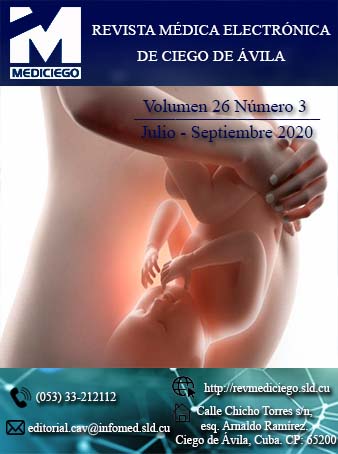Results of the application of the Nd: Yag Laser in cataract operated with posterior capsule opacity
Abstract
Introduction: opacity of the posterior lens capsule is the most frequent late postoperative complication of cataract surgery, associated with decreased vision. Posterior capsulotomy with neodymium YAG laser is the choice treatment.
Objective: to evaluate the efficacy of the application of posterior capsulotomy with neodymium YAG laser in patients with opacity of the posterior lens capsule, developed after cataract operation.
Methods: a pre-experimental study was carried out in the universe of 126 patients (135 eyes) operated on for cataract who developed opacity of the posterior capsule, treated at the Ophthalmological Center of Ciego de Ávila between January and December 2019. Data were extracted from individual medical records. Descriptive and inferential statistics were applied. Bioethical principles were met.
Results: female patients (57,14 %), the age group from 70 to 79 years (39,68 %) and the ocular pathological history of simple chronic glaucoma (8,73 %) predominated. The most frequent complication was damage to the intraocular lens (15,56 %). The mean value of intraocular pressure was 14,5 mm Hg before capsulotomy, and 15,4 mm Hg two hours after. Visual acuity one month after the procedure improved in most patients.
Conclusions: the opacity of the posterior capsule maintains a high incidence in cataract surgery. Neodymium YAG laser treatment was effective in achieving a positive and significant modification of best-corrected visual acuity, with a minimum of complications.Downloads
Published
How to Cite
Issue
Section
License
Copyright (c) 2021 Yaney Zayas Ribalta

This work is licensed under a Creative Commons Attribution-NonCommercial 4.0 International License.
Those authors who have publications with this journal accept the following terms of the License CC Attribution-NonCommercial 4.0 International (CC BY-NC 4.0):
You are free to:
- Share — copy and redistribute the material in any medium or format for any purpose, even commercially.
- Adapt — remix, transform, and build upon the material for any purpose, even commercially.
The licensor cannot revoke these freedoms as long as you follow the license terms.
Under the following terms:
- Attribution — You must give appropriate credit , provide a link to the license, and indicate if changes were made . You may do so in any reasonable manner, but not in any way that suggests the licensor endorses you or your use
- No additional restrictions — You may not apply legal terms or technological measures that legally restrict others from doing anything the license permits.
The journal is not responsible for the opinions and concepts expressed in the works, which are the exclusive responsibility of the authors. The Editor, with the assistance of the Editorial Committee, reserves the right to suggest or request advisable or necessary modifications. Original scientific works are accepted for publication, as are the results of research of interest that have not been published or sent to another journal for the same purpose.
The mention of trademarks of specific equipment, instruments or materials is for identification purposes, and there is no promotional commitment in relation to them, neither by the authors nor by the editor.






















